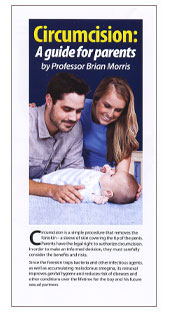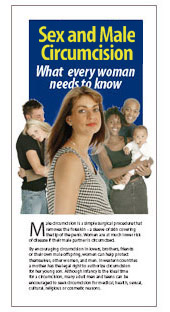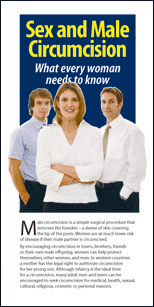Circumcision - Benefits Outweigh the Risks
Dr Tom Wiswell, a respected authority in the USA was a strong opponent, but then switched camps as a result of his own research findings and the findings of others. This is what he has to say: "As a pediatrician and neonatologist, I am a child advocate and try to do what is best for children. For many years I was an outspoken opponent of circumcision ... I have gradually changed my opinion" [Wiswell, 1988; Wiswell, 1992]. This ability to keep an open mind on the issue and to make a sound judgement on the balance of all available information is to his credit ... he did change his mind!
Wiswell looked at the complication rates of having or not having circumcision performed in a study of 136,000 boys born in US army hospitals between 1980 and 1985. 100,000 were circumcised and 193 (0.19%) had complications, mostly minor, with no deaths, but of the 36,000 who were not circumcised the problems were more than ten-times higher and there were 2 deaths [Wiswell & Hachey, 1993].
A study by others found that of the 11,000 circumcisions performed at New York's Sloane Hospital in 1989, only 6 led to complications, none of which were fatal [Russell, 1993]. An early survey saw only one death amongst 566,483 baby boys circumcised in New York between 1939 and 1951 [National, 2003].
There are no deaths today from medical circumcisions in developed countries.
Very similar to the study by Wiswell above, it was found that of 354,297 infants born in Washington State from 1987-96, only 0.20% had a complication arising from their circumcision, i.e., 1 in every 476 circumcisions [Christakis et al., 2000]. Most of these ‘complications’ were minor and readily treated. It was concluded that 6 urinary tract infections could be prevented for every circumcision complication, and 2 complications can be expected for every penile cancer prevented [Christakis et al., 2000].
Problems involving the penis are encountered relatively frequently in pediatric practice [Langer & Coplen, 1998]. A retrospective study of boys aged 4 months to 12 years found uncircumcised boys exhibited significantly greater frequency of penile problems (14% vs 6%; P < 0.001) and medical visits for penile problems (10% vs 5%; P < 0.05) compared with those who were circumcised.
Risk-benefit analyses
To ascertain how much the benefits exceed the risks various risk-benefit analyses have been conducted over the years. With time, and increased high-quality evidence, the benefits to risk ratio has increased from 1 in 100 to 1 in 200 [Morris et al. 2006; Morris 2007; Morris et al. 2012 (BMC Pediatr & Open J Prevent Med), 2014a (Mayo Clin Proc), 2016a (Can J Urol), 2017e (World J Clin Pediatr), 2022 (J Menís Health)].



